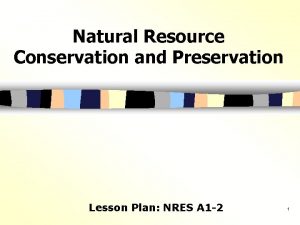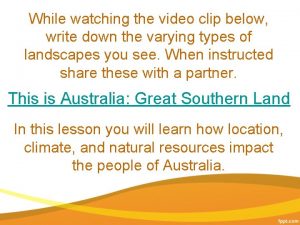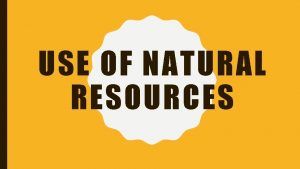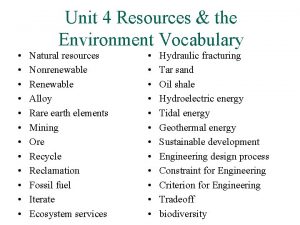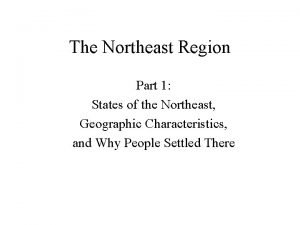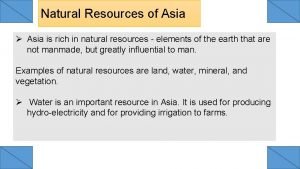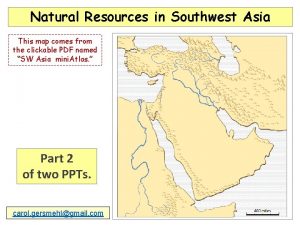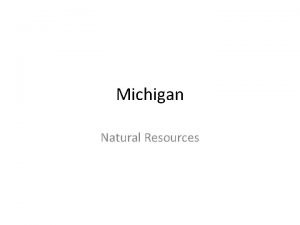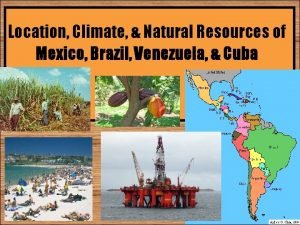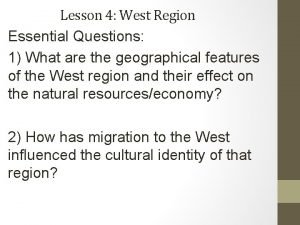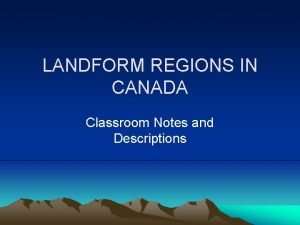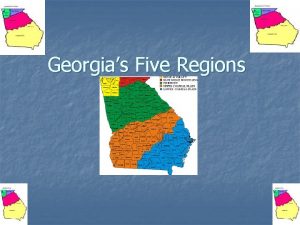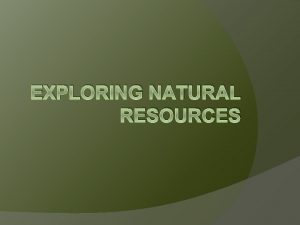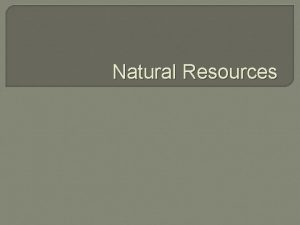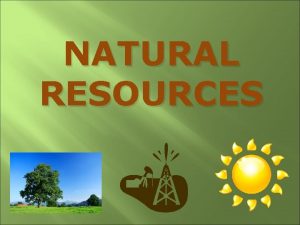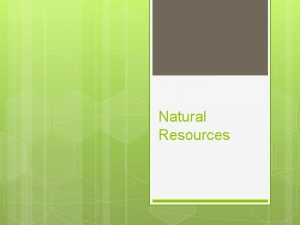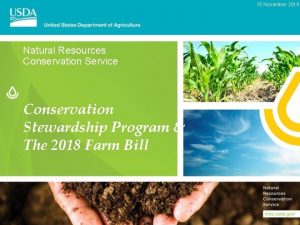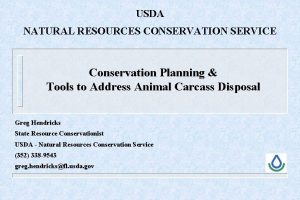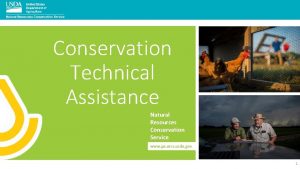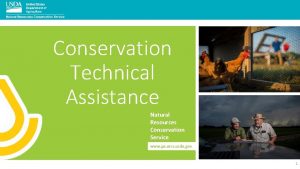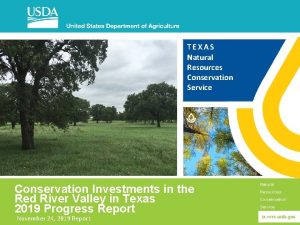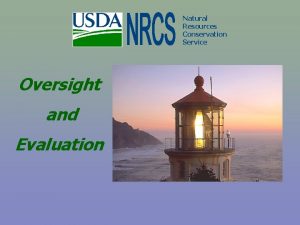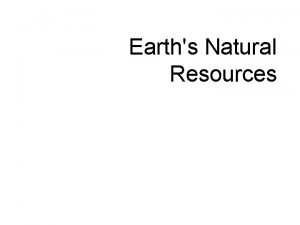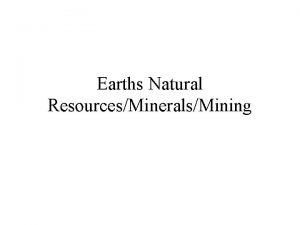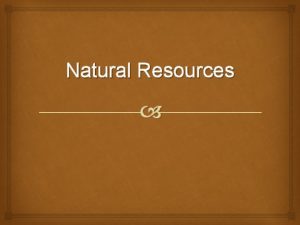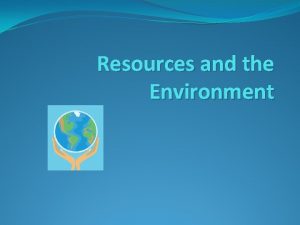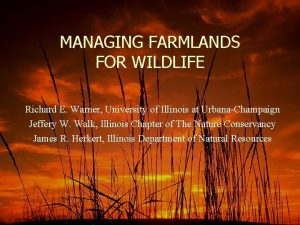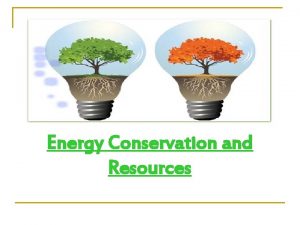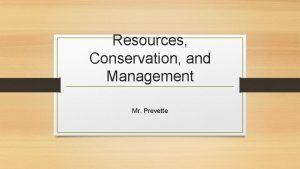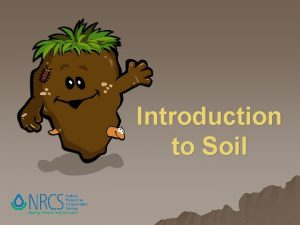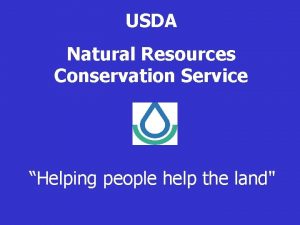Working Farmlands Natural Resources Conservation Service in the


























- Slides: 26

Working Farmlands Natural Resources Conservation Service in the Ocean State Working Forestlands - Working Farmlands, Forestlands, & Waters Vision: Productive Lands – Healthy Environment USDA is an equal opportunity provider, employer, and lender. Working Waters

NRCS is the lead federal agency in the USDA that helps private landowners voluntarily conserve soil, water, and other natural resources Healthy Plants Productive Soil Mission: Helping People Help the Land Clean Water

What do we do? • We provide technical assistance to help landowners develop and implement conservation plans for their property. • We provide financial assistance to both protect and restore natural resources. • We develop and maintain technical standards for conservation practices (BMP’s). • We develop and maintain the nation’s database on soils.

How do we Work? • We work: – Primarily on Private Lands – Closely with Conservation Districts, Local, Citizenbased, & other conservation organization partners • We emphasize – – – Science-based conservation Technical assistance Partnerships Incentive-based programs Cooperative problem solving at the community level

Conservation Cost Assistance Programs – Environmental Quality Incentives Program (EQIP) – Agricultural Management Assistance Program (AMA)

Environmental Quality Incentives Program (EQIP) – A Conservation Cost-Share Program – A voluntary conservation program that provides technical and financial assistance to improve resource concerns related to soil, water, air, plants, animals and other related natural resources on their land. – Persons engaged in livestock or agricultural production and owners of nonindustrial private forestland are eligible for EQIP. – Eligible land use includes cropland, rangeland, pastureland, private nonindustrial forestland, and other farm or ranch lands.

EQIP Projects Agricultural Water Use – Irrigation Water Management

EQIP Projects Pasture Management

EQIP Projects Manure Management

EQIP Projects Forest Management

EQIP Projects Aquaculture – Oyster Reef Restoration

EQIP Projects High Tunnels

Conservation Activity Plans (CAPs) • CAPs are management plans funded through EQIP that are developed by Technical Service Providers (TSPs). These individuals and/or entities are certified to develop activity (management) plans for the various resource concern(s) that has/have been identified. • CAPs offered through EQIP include: – Forest Management Plan – Grazing Management Plan – Irrigation Water Management – Comprehensive Nutrient Management – Integrated Pest Management - Fish and Wildlife Management - Agricultural Energy Management - Transition to Organic - Pollinator Habitat Plan - Air Quality Management • CAPs are funded in a separate contract with the client. • CAP applications are batched and evaluated for funding throughout the year on a continuous basis.

EQIP Eligibility Requirements § To participate in EQIP you need to: – Have control of the land for the term of the proposed contract. Renting and leasing land is fine, as long as you can document that you have control of the land for the duration of your contract. – Have an average Adjusted Gross Income (AGI) of $900, 000 dollars or less. – Have a financial and/or legal interest in the farming operation associated with the land being enrolled. – Be in compliance with Highly Erodible Land & Wetland Conservation Provisions. *NOTE: NRCS and your Conservation District will help landowner establish contract eligibility requirements

Agricultural Management Assistance Program (AMA) – A Cost-Share Conservation Program – Objective of AMA is to address those items most likely to cause risk to a farmer’s long term viability, such as drought-related crop losses. – Financial assistance in Rhode Island is primarily available to help farmers defray the costs of: • installing new conservation irrigation systems • converting to conservation irrigation from sprinkler irrigation • extending the growing season through High Tunnel installation – AMA has a limited practice list that is established each year

AMA Projects Conservation Irrigation System

Conservation Stewardship Program (CSP) CSP is a voluntary conservation program that encourages producers to maintain high levels of conservation stewardship and address new resource concerns in a comprehensive manner by: – Undertaking additional conservation activities; and – Improving, maintaining, and managing existing conservation activities. CSP is available on Tribal and private agricultural lands and non-industrial private forest land CSP participants receive an annual land use payment for operation-level environmental benefits they produce and an annual payment for newly adopted conservation activities. Under CSP, participants are paid for conservation performance: the higher the operational performance, the higher their payment.

How do I get assistance? 1. Contact NRCS or the Conservation District to request technical assistance for the development of a conservation plan. 2. An NRCS Planner or Conservation District employee will contact you to schedule a site visit and conduct a resource inventory. 3. Your planner will work with you to develop a Conservation Plan that includes your goals and objectives.

Conservation Program Application Process Note: Once your Conservation Plan has been completed you may be eligible for financial assistance to implement one or several conservation practices. 1. Work with your planner to determine conservation practices that may be eligible for financial assistance. 2. Submit a Conservation Program Application (CPA-1200). 3. Work with NRCS to complete eligibility requirements. 4. Application will be ranked against all other applications. 1. 2. Applications will be preapproved based on ranking criteria, in order from highest to lowest score. Applications will be funded based on ranking score and the availability of funding. 5. Sign contract documents and then you can begin implementing the contract. (No work commenced prior to contract approval is eligible for program payments).

Programs Available under Agricultural Conservation Easement Programs (ACEP) in Rhode Island • • Agricultural Land Easements (ACEP-ALE): Financial assistance for eligible partners – 50 percent of the fair market value of the agricultural land easement. – Where NRCS determines that grasslands of special environmental significance will be protected, NRCS may contribute up to 75 percent of the fair market value of the agricultural land easement • • Wetland Reserve Easements(ACEP-WRE): NRCS also provides technical and financial assistance directly to private landowners and Indian tribes to restore, protect, and enhance wetlands through the purchase of a wetland reserve easement. Permanent easements may be available for up to 90% of the fair market value.

ALE: Land Eligibility Criteria Private Land that: • Has prime, unique or other productive soils (Soils) • Contains historical or archaeological resources • Enrollment would protect grazing uses and related conservation values by restoring and conserving land (Grassland) • Further a State or local policy consistent with the purposes of ACEP-ALE

Web Soil Survey - http: //websoilsurvey. sc. egov. usda. gov/App/Home. Page. htm

• Soils Eligibility

ACEP-Wetland Reserve Easement Program Objectives 1. Habitat for migratory birds and other wetland-dependent wildlife, including endangered or threatened species and species of concern. 2. Protection and improvement of water quality. 3. Attenuation of floodwater. 4. Recharge of ground water. 5. Protection and enhancement of open space and aesthetic quality. 6. Carbon sequestration. 7. Protection of native flora and fauna contributing to the Nation's natural heritage. 8. Contribution to educational and scientific scholarship.

FOR MORE INFORMATION, VISIT https: //www. nrcs. usda. gov/wps/portal/nr cs/main/ri/programs/farmbill/rcpp/

Contact information: USDA NRCS 60 Quaker Lane, Suite 40 Warwick, RI 02886 401 -828 -1300 x 1 USDA is an equal opportunity provider, employer, and lender.
 Lesson plan on conservation of natural resources
Lesson plan on conservation of natural resources Smart work vs hard work
Smart work vs hard work Cold working disadvantages
Cold working disadvantages Hot working and cold working difference
Hot working and cold working difference Machining operations
Machining operations Proses hot working
Proses hot working What is transformed resources
What is transformed resources Fixed resources examples
Fixed resources examples Renewable resources vs nonrenewable resources
Renewable resources vs nonrenewable resources Australia major natural resources
Australia major natural resources Central australia natural resources
Central australia natural resources What are the 4 types of natural resources
What are the 4 types of natural resources Natural resources vocabulary
Natural resources vocabulary Northeast physical characteristics
Northeast physical characteristics Warsaw pact countries
Warsaw pact countries Natural resources of asia
Natural resources of asia Resources in southwest asia
Resources in southwest asia What is michigan's natural resources
What is michigan's natural resources What are cuba's natural resources
What are cuba's natural resources West region natural resources
West region natural resources 8 landform regions of canada
8 landform regions of canada Australia natural resources
Australia natural resources The five regions of georgia
The five regions of georgia Explain natural resources
Explain natural resources Japan major natural resources
Japan major natural resources Japan natural resources
Japan natural resources Japan natural resources
Japan natural resources
